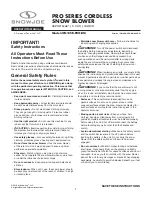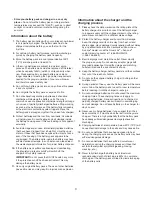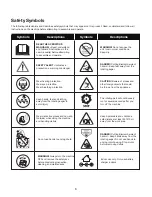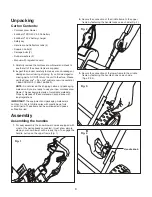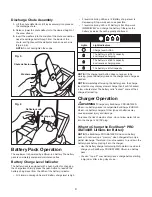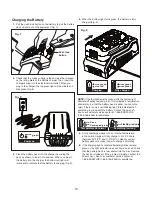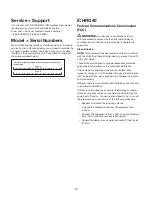
15
Replacing the Scraper Bar
1. The scraper bar is located at the base of the snow blower
beneath the rotor housing (Fig. 22).
2. Detach the worn scraper bar from the snow blower by
removing the 4 screws that hold it in place (Fig. 23).
3. Install the new scraper bar and fasten it securely to the
snow blower with 4 screws
(Fig. 22).
Storage
1.
Examine the cordless snow blower thoroughly for worn,
loose or damaged parts. Should you need to repair or
replace a part, contact an authorized Snow Joe
®
+
Sun Joe
®
dealer or call the Snow Joe
®
+ Sun Joe
®
customer service center at 1-866-SNOWJOE
(1-866-766-9563) for assistance.
2. Clean the snow blower before storing or transporting.
Be sure to secure the unit while transporting.
3. Remove the battery and the safety key from the cordless
snow blower before storing.
4. Store the cordless snow blower indoors
in a locked, dry
place out of the reach of children to prevent unauthorized
use or damage.
B Charger Off-Season Storage
1.
Do not expose your battery pack or charger to water,
rain or allow them to get wet. This could permanently
damage the charger and the battery pack. Do not use oil
or solvents to clean or lubricate your battery pack as the
plastic casing can become brittle and crack, causing a
serious risk of injury.
2. Store the battery pack and charger at room temperature
away from moisture. Do not store in damp locations where
corrosion of terminals may occur. As with other battery
pack types, permanent capacity loss can result if the pack
is stored for long periods of time at high temperatures
(over 120ºF/49ºC).
3. EcoSharp
®
PRO iBAT40XR lithium-ion battery packs
maintain their charge during storage longer than other
battery pack types. As a general practice, it is best to
unplug the battery charger and remove the battery pack
when they are not in use. Recharge the battery pack every
6 months to 50% capacity (2 lights on) during off-season
storage to maintain optimal battery performance.
Battery C
Disposal Information
Always dispose of your battery pack according to federal,
state, and local regulations. Contact a recycling agency in your
area for recycling locations.
m
CAUTION!
Even discharged battery packs contain
some energy. Before disposing, use electrical tape to cover
the terminals to prevent the battery pack from shorting, which
could cause a fire or explosion.
m
WARNING!
To reduce the risk of injury or explosion,
never burn or incinerate a battery pack even if it is damaged,
dead or completely discharged. When burned, toxic fumes
and materials are emitted into the surrounding atmosphere.
1. Batteries vary according to device. Consult your manual
for specific information.
2. Install only new batteries of the same type in your product
(where applicable).
3.
Failure to insert batteries in the correct polarity, as
indicated in the battery compartment or manual, may
shorten the life of the batteries or cause batteries to leak.
4.
Do not mix old and new batteries.
5.
Do not mix Alkaline, Standard (Carbon-Zinc) or
Rechargeable (Nickel Cadmium, Nickel Metal Hydride, or
Lithium-Ion) batteries.
6.
Do not dispose of batteries in fire.
7. Batteries should be recycled or disposed of as per state
and local guidelines.
Fig. 22
Scraper bar
4 Screws
Fig. 23

